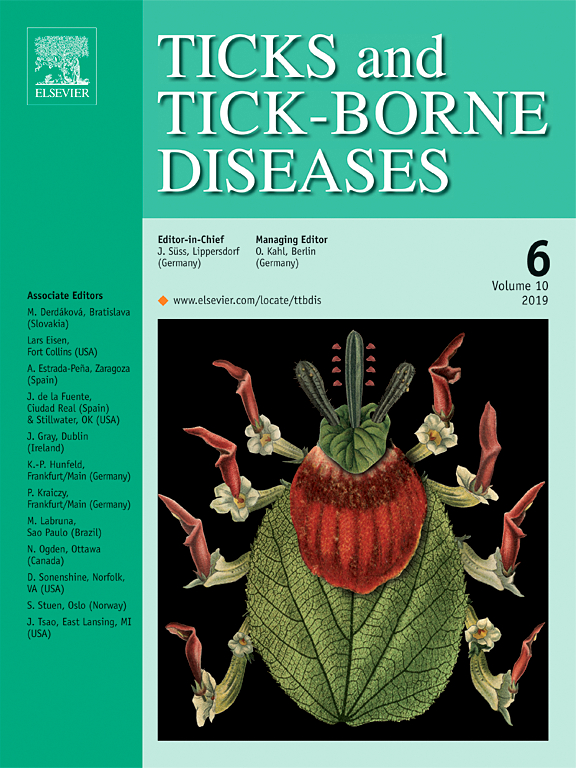Ver ítem
- xmlui.general.dspace_homeCentros e Institutos de InvestigaciónCICVyA. Centro de Investigación en Ciencias Veterinarias y AgronómicasInstituto de BiotecnologíaArtículos científicosxmlui.ArtifactBrowser.ItemViewer.trail
- Inicio
- Centros e Institutos de Investigación
- CICVyA. Centro de Investigación en Ciencias Veterinarias y Agronómicas
- Instituto de Biotecnología
- Artículos científicos
- Ver ítem
Immunisation of cattle against Babesia bovis combining a multi-epitope modified vaccinia Ankara virus and a recombinant protein induce strong Th1 cell responses but fails to trigger neutralising antibodies required for protection
Resumen
Protection against the intraerythrocytic protozoan parasite Babesia bovis depends on both strong innate and adaptive immune response, this latter involving the presentation of parasite antigens to CD4+ T-lymphocytes by professional antigen-presenting cells. Secretion of Th1 cytokines by CD4+ T cell is also very important for isotype switching to IgG2, the best opsonising antibody isotype in cattle, to target extracellular parasites and parasite antigens
[ver mas...]
Protection against the intraerythrocytic protozoan parasite Babesia bovis depends on both strong innate and adaptive immune response, this latter involving the presentation of parasite antigens to CD4+ T-lymphocytes by professional antigen-presenting cells. Secretion of Th1 cytokines by CD4+ T cell is also very important for isotype switching to IgG2, the best opsonising antibody isotype in cattle, to target extracellular parasites and parasite antigens displayed at the erythrocyte surface. In the field of vaccinology, heterologous prime-boost schemes combining protein-adjuvant formulations with a modified vaccinia Ankara vector expressing the same antigen have demonstrated the induction of both humoral and cellular immune responses. It has been previously demonstrated that MVA-infected dendritic cells can present antigens in the context of MHC II and activate CD4+ T cell. These results support the use of the MVA viral vector for a pathogen like Babesia bovis, which only resides within erythrocytes. In this study, 13-15-months-old Holstein-Friesian steers were immunised with a subunit vaccine as a prime and a modified vaccinia Ankara vector as a boost, both expressing a chimeric multi-antigen (rMABbo - rMVA). This antigen includes the immunodominant B and T cell epitopes of three B. bovis proteins: merozoite surface antigen - 2c (MSA - 2c), rhoptry associated protein 1 (RAP - 1) and heat shock protein 20 (HSP20). Responses were compared with the Babesia bovis live attenuated vaccine used in Argentina (R1A). Eleven weeks after the first immunisation, all bovines were challenged by the inoculation of a virulent B. bovis strain. All groups were monitored daily for hyperthermia and reduction of packed cell volume. Both the rMABbo - rMVA and R1A vaccinated animals developed high titters of total IgG antibodies and an antigen-specific Th1 cellular response before and after challenge. However, all rMABbo - rMVA steers showed clinical signs of disease upon challenge. Only the R1A live vaccine group developed an immune response associated with in vitro neutralising antibodies at a level that significantly inhibited the parasite invasion. The lack of protection observed with this recombinant formulation indicates the need to perform further basic and clinical studies in the bovine model in order to achieve the desired effectiveness. This is the first report in which a novel vaccine candidate against Babesia bovis was constructed based on a recombinant and rationally designed viral vector and evaluated in the biological model of the disease.
[Cerrar]

Autor
Jaramillo Ortiz, Jose Manuel;
Paoletta, Martina;
Gravisaco, María José;
Lopez Arias, Ludmila Sol;
Montenegro, Valeria Noely;
De La Fourniere, Sofia;
Valenzano, Magali Nicole;
Guillemi, Eliana Carolina;
Valentini, Beatriz Susana;
Echaide, Ignacio Eduardo;
Farber, Marisa Diana;
Wilkowsky, Silvina Elizabeth;
Fuente
Ticks and tick-borne diseases 10 (6) : 101270. (Octubre 2019)
Fecha
2019-10
Editorial
Elsevier
ISSN
1877-959X
Formato
pdf
Tipo de documento
artículo
Palabras Claves
Derechos de acceso
Restringido
 Excepto donde se diga explicitamente, este item se publica bajo la siguiente descripción: Creative Commons Attribution-NonCommercial-ShareAlike 2.5 Unported (CC BY-NC-SA 2.5)
Excepto donde se diga explicitamente, este item se publica bajo la siguiente descripción: Creative Commons Attribution-NonCommercial-ShareAlike 2.5 Unported (CC BY-NC-SA 2.5)

